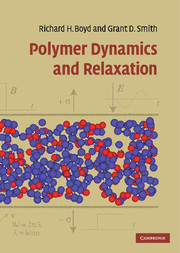Part II - Amorphous polymers
Published online by Cambridge University Press: 10 November 2009
Summary
Amorphous polymers represent in one sense the simplest class of polymers in that they have no intermediate microstructure between that of the macroscopic specimen and the molecular level. Very often intermediate scale microstructures have an influence on relaxational behavior and thus wholly amorphous polymers are a good baseline to which more complicated structures can be compared. In another sense the amorphous state is exceedingly complicated. At an atomistic level it is difficult to describe or model an interpenetrating collection of chains, each pursuing a more or less random spatial trajectory. In a given amorphous polymer usually more than one region of relaxation in time and temperature can be detected. The term amorphous implies that, if chemical stability is adequate, at some high temperature the polymer exists as a viscous liquid or melt and that at sufficiently low temperature vitrification will take place. The relaxation process associated with the glass transition region is thus very prominent. Usually, however, one or more additional relaxation processes are found at temperatures below the glass transition temperature. The glass transition relaxation region and subglass relaxations each have their own set of common characteristics or “signatures.” MD simulations are now able to accomplish the modeling of the structure of amorphous polymers and over time trajectories long enough to be useful in interpreting the relaxation processes.
A word about the nomenclature used in denoting multiple relaxation processes in the same polymer is in order.
- Type
- Chapter
- Information
- Polymer Dynamics and Relaxation , pp. 81 - 82Publisher: Cambridge University PressPrint publication year: 2007

